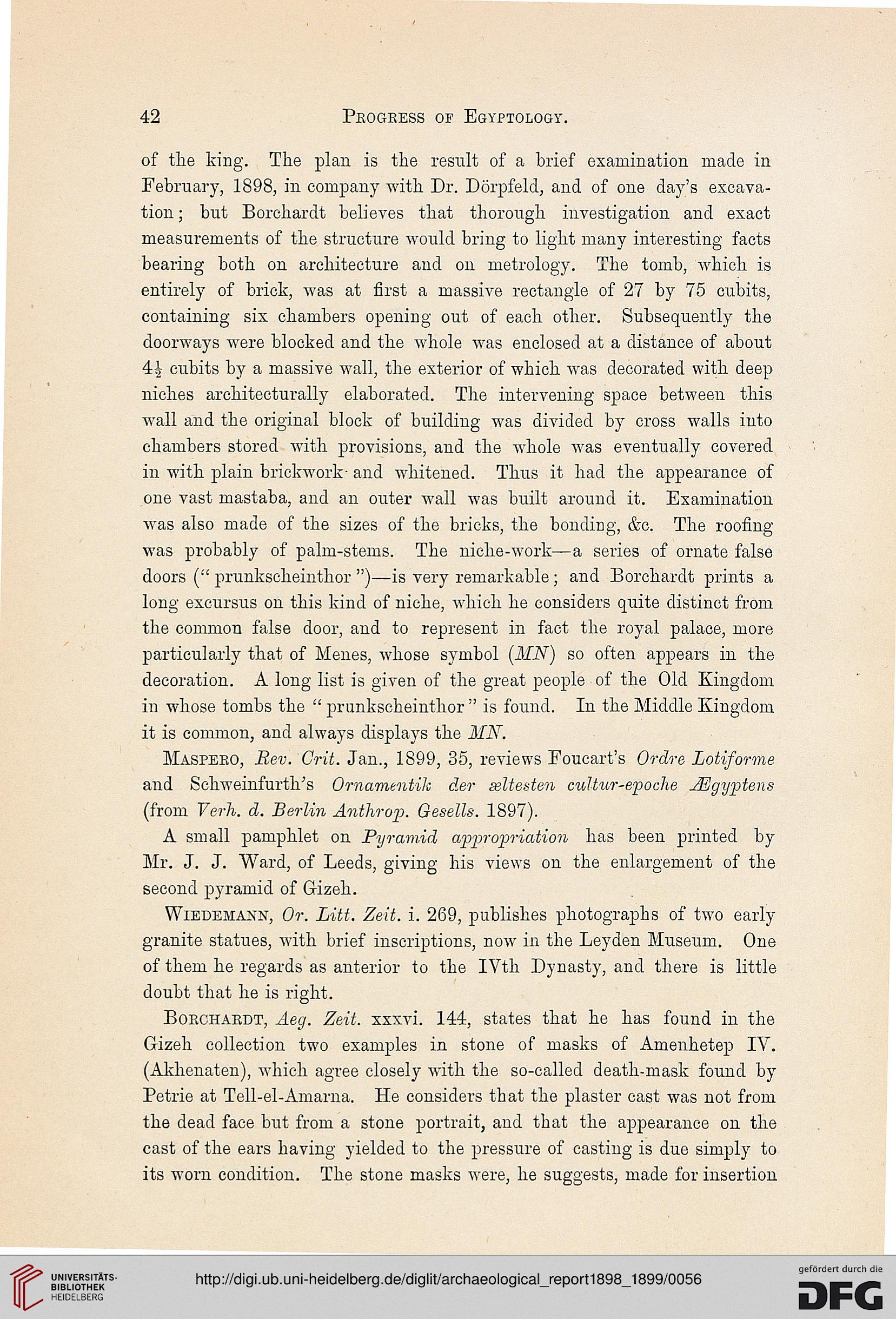42
Progress of Egyptology.
of the king. The plan is the result of a brief examination made in
February, 1898, in company with Dr. Dorpfeld, and of one clay's excava-
tion ; but Borchardt believes that thorough investigation and exact
measurements of the structure would bring to light many interesting facts
bearing both on architecture and on metrology. The tomb, which is
entirely of brick, was at first a massive rectangle of 27 by 75 cubits,
containing six chambers opening out of each other. Subsequently the
doorways were blocked and the whole was enclosed at a distance of about
4l\ cubits by a massive wall, the exterior of which was decorated with deep
niches architecturally elaborated. The intervening space between this
wall and the original block of building was divided by cross walls into
chambers stored with provisions, and the whole was eventually covered
in with plain brickwork- and whitened. Thus it had the appearance of
one vast mastaba, and an outer wall was built around it. Examination
was also made of the sizes of the bricks, the bonding, &c. The roofing
was probably of palm-stems. The niche-work—a series of ornate false
doors (" prunkscheinthor ")—is very remarkable; and Borchardt prints a
long excursus on this kind of niche, which he considers quite distinct from
the common false door, and to represent in fact the royal palace, more
particularly that of Menes, whose symbol (MN) so often appears in the
decoration. A long list is given of the great people of the Old Kingdom
in whose tombs the " prunkscheinthor " is found. In the Middle Kingdom
it is common, and always displays the MN~.
Maspero, Rev. Crit. Jan., 1899, 35, reviews Eoucart's Ordre Lotiforme
and Schweinfurth's Ornamentik der seltesten cultur-epoclie JEgijptens
(from Verh. d. Berlin Anthrop. Gesells. 1897).
A small pamphlet on Pyramid appropriation has been printed by
Mr. J. J. Ward, of Leeds, giving his views on the enlargement of the
second pyramid of Gizeh.
Wiedemann, Or. Litt. Zeit. i. 269, publishes photographs of two early
granite statues, with brief inscriptions, now in the Leyden Museum. One
of them he regards as anterior to the IVth Dynasty, and there is little
doubt that he is right.
Borchardt, Aeg. Zeit. xxxvi. 144, states that he has found in the
Gizeh collection two examples in stone of masks of Amenhetep IT.
(Akhenaten), which agree closely with the so-called death-mask found by
Petrie at Tell-el-Amarna. He considers that the plaster cast was not from
the dead face but from a stone portrait, and that the appearance on the
cast of the ears having yielded to the pressure of casting is due simply to
its worn condition. The stone masks were, he suggests, made for insertion
Progress of Egyptology.
of the king. The plan is the result of a brief examination made in
February, 1898, in company with Dr. Dorpfeld, and of one clay's excava-
tion ; but Borchardt believes that thorough investigation and exact
measurements of the structure would bring to light many interesting facts
bearing both on architecture and on metrology. The tomb, which is
entirely of brick, was at first a massive rectangle of 27 by 75 cubits,
containing six chambers opening out of each other. Subsequently the
doorways were blocked and the whole was enclosed at a distance of about
4l\ cubits by a massive wall, the exterior of which was decorated with deep
niches architecturally elaborated. The intervening space between this
wall and the original block of building was divided by cross walls into
chambers stored with provisions, and the whole was eventually covered
in with plain brickwork- and whitened. Thus it had the appearance of
one vast mastaba, and an outer wall was built around it. Examination
was also made of the sizes of the bricks, the bonding, &c. The roofing
was probably of palm-stems. The niche-work—a series of ornate false
doors (" prunkscheinthor ")—is very remarkable; and Borchardt prints a
long excursus on this kind of niche, which he considers quite distinct from
the common false door, and to represent in fact the royal palace, more
particularly that of Menes, whose symbol (MN) so often appears in the
decoration. A long list is given of the great people of the Old Kingdom
in whose tombs the " prunkscheinthor " is found. In the Middle Kingdom
it is common, and always displays the MN~.
Maspero, Rev. Crit. Jan., 1899, 35, reviews Eoucart's Ordre Lotiforme
and Schweinfurth's Ornamentik der seltesten cultur-epoclie JEgijptens
(from Verh. d. Berlin Anthrop. Gesells. 1897).
A small pamphlet on Pyramid appropriation has been printed by
Mr. J. J. Ward, of Leeds, giving his views on the enlargement of the
second pyramid of Gizeh.
Wiedemann, Or. Litt. Zeit. i. 269, publishes photographs of two early
granite statues, with brief inscriptions, now in the Leyden Museum. One
of them he regards as anterior to the IVth Dynasty, and there is little
doubt that he is right.
Borchardt, Aeg. Zeit. xxxvi. 144, states that he has found in the
Gizeh collection two examples in stone of masks of Amenhetep IT.
(Akhenaten), which agree closely with the so-called death-mask found by
Petrie at Tell-el-Amarna. He considers that the plaster cast was not from
the dead face but from a stone portrait, and that the appearance on the
cast of the ears having yielded to the pressure of casting is due simply to
its worn condition. The stone masks were, he suggests, made for insertion





